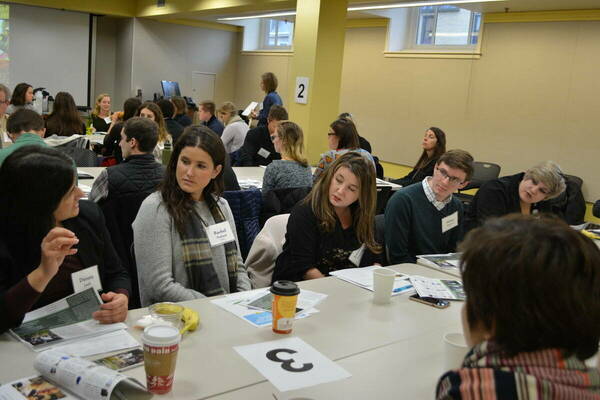

At the end of every semester, architecture students pin up their studio projects and formally present to faculty, visiting critics, and peers during design “reviews.” Students in Assistant Professor Kim Rollings’ Social Factors and Sustainability: Effects of the Built Environment on Health course, however, join South Bend community partners for informal group discussions about their community-based final projects. Students collaborate with local community organizations to develop solutions to a real-world problem. Project formats range from design guidelines to community surveys and research reports.
Drawing from architecture, landscape architecture, urban planning, environmental psychology, and public health, Prof. Rollings’ interdisciplinary course introduces the complex connections between the built environment, health, and sustainability, with a focus on vulnerable populations. The interdisciplinary course attracts students from a variety of disciplines including architecture, design, pre-health, the sciences and social sciences, engineering, and business. Students offer multiple perspectives during discussions and are required to support their ideas with research evidence from multiple disciplines.
The community-based semester project requires that students select a topic of interest and identify a relevant community professional. Students apply course content to a problem defined by their partners and create a “deliverable” for the organization. Projects have included design guidelines for restorative spaces for college campuses and homeless youth, public lactation spaces, trauma-informed care facilities, green spaces and native landscaping, and environmentally sustainable material recommendations for affordable housing. The project offers students the opportunity to serve the community through their real-world work.
Current architecture student, Matthew Schaefer, credits Prof. Rollings’ class for providing him with the foundational knowledge and skills to conduct future community-based work relating to architecture and health. Schaefer’s class project developed design guidelines for a walking trail associated with the Bowman Creek Project. He later partnered with South Bend Venues, Parks and Arts to develop his design thesis and sustainability minor capstone: a recreation center for Howard Park and sustainability standards for the Riverfront Development Project. His work aims to provide local architects and city planners with evidence-based designs and guidelines for healthy, sustainable park facilities.
Prof. Rollings’ class highlights the responsibility that architects have to design environments that promote health and sustainability for all people. Student efforts exemplify the powerful and interdisciplinary work that can be accomplished when people recognize the effects of architecture on our health.
Originally published by at architecture.nd.edu on March 23, 2017.